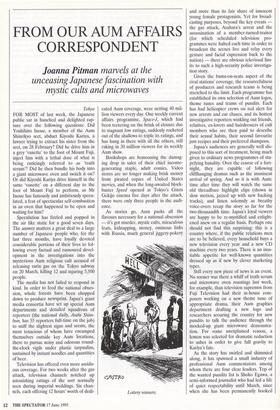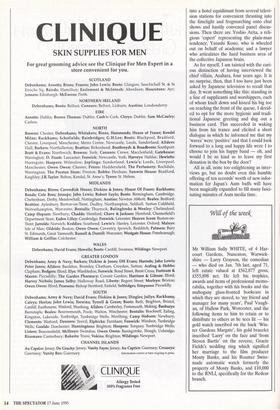FROM OUR AUM AFFAIRS CORRESPONDENT
Joanna Pitman marvels at the
unceasing Japanese fascination with mystic cults and microwaves
Tokyo FOR MOST of last week, the Japanese public sat in hunched and delighted rap- ture over the following questions: Did Yoshihiro Inoue, a member of the Aum Shinrikyo sect, abduct Kiyoshi Kariya, a lawyer trying to extract his sister from the sect, on 28 February? Did he drive him in a grey `vanette' to the foot of Mount Fuji, inject him with a lethal dose of what is being enticingly referred to as 'truth serum'? Did he then bundle his body into a giant microwave oven and switch it on? Or did Kiyoshi Kariya drive himself in the same `vanette' on a different day to the foot of Mount Fuji to perform, as Mr Inoue has famously and ambitiously specu- lated, a feat of spectacular self-combustion in an oven that happened to be open and waiting for him?
Speculation has fizzled and popped in the air like static for a good seven days. The answer matters a great deal to a large number of Japanese people who, for the last three months, have loyally devoted considerable portions of their lives to fol- lowing every factual and rumoured devel- opment in the investigations into the mysterious Aum religious cult accused of releasing sarin gas on the Tokyo subway on 20 March, killing 12 and injuring 5,500 people.
The media has not failed to respond in kind. In order to feed the national obses- sion, whole forests have been chopped down to produce newsprint. Japan's giant media consortia have set up special Aum departments and detailed squadrons of reporters (the national daily, Asahi Shim- bun, has 55 reporters full-time on the job) to sniff the slightest signs and scents, the most tenacious of whom have encamped themselves outside key Aum locations, there to pursue noisy and odorous round- the-clock vigils under plastic tarpaulins, sustained by instant noodles and quantities of beer.
Television has offered even more assidu- ous coverage. For two weeks after the gas attack, television channels notched up astonishing ratings of the sort normally seen during imperial weddings. Six chan- nels, each offering 12 hours' worth of dedi- cated Aum coverage, were netting 40 mil- lion viewers every day. One weekly current affairs programme, Space-J, which had been teetering on the brink of closure due to stagnant low ratings, suddenly rocketed out of the shallows to triple its ratings, and has hung in there with all the others, still raking in 30 million viewers for its weekly Aum show.
Bookshops are bemoaning the damag- ing drop in sales of their chief income- generating staple, adult comics. Video stores are no longer making brisk money from pirated copies of United States movies, and when the long-awaited block- buster Speed opened at Tokyo's Ginza Gekijo cinema five days after the attack, there were only three people in the audi- ence.
As stories go, Aum packs all the flavours necessary for a national obsession — it's got murder, mystic cults, miraculous feats, kidnapping, money, ominous links with Russia, much general jiggery-pokery Lottery winners. and more than its fair share of innocent young female protagonists. Yet for broad- casting purposes, beyond the key events the gas attack, Asahara's arrest and the assassination of a member-turned-traitor (for which scheduled television pro- grammes were halted each time in order to broadcast the scenes live and relay every gesture and facial expression back to the nation) — there are obvious televisual lim- its to such a high-security police investiga- tion story.
Given the bums-on-seats aspect of the rival stations' coverage, the resourcefulness of producers and research teams is being stretched to the limit. Each programme has established its own selection of Aum logos, theme tunes and teams of pundits. Each has had helicopter crews on red alert for new arrests and car chases, and its hottest investigative reporters winkling out friends, relatives, ex-lovers and hairdressers of cult members who are then paid to describe their sexual habits, their second favourite jam recipes and their preferred shampoos.
Japan's audiences are generally well dis- posed to this sort of treatment, being much given to ordinary news programmes of stu- pefying banality. Over the course of a fort- night, they are capable of following cliffhanging dramas such as the imminent arrival of spring. And so it is with Aum: time after time they will watch the same old threadbare highlight clips (shown in slow motion, jazzed up with new backing tracks), and listen solemnly as breathy voice-overs recap the story so far for the two-thousandth time. Japan's loyal viewers are happy to be re-mystified and enlight- ened anew on a regular basis. Perhaps one should not find this surprising: this is a country where, if the public relations men are to be believed, every household buys a new television every year and a new CD machine every two years. There is an insa- tiable appetite for well-known quantities dressed up as if new by clever marketing types.
Still every new piece of news is an event. No sooner was there a whiff of truth serum and microwave oven roastings last week, for example, than television supremos from Fuji Television had their in-house com- posers working on a new theme tune of appropriate drama, their Aum graphics department drafting a new logo and researchers scouring the country for new pundits to talk the audience through the mocked-up giant microwave demonstra- tion. For some unexplained reason, a lemon was selected for dramatic reduction to ashes in order to give full gravity to Kariya's fate.
As the story has swirled and shimmied along, it has spawned a small industry of professional Aum commentators among whom there are four clear leaders. Top of the wanted pundits list is Shoko Egawa, a semi-informed journalist who had led a life of quiet respectability until March, since when she has been permanently booked into a hotel equidistant from several televi- sion stations for convenient thrusting into the limelight and frogmarching onto chat shows and hastily convened panel discus- sions. Then there are Yoshio Arita, a reli- gious 'expert' representing the plain-man tendency; Yasushi Kono, who is wheeled out on behalf of academia; and a lawyer who articulates the hard business area of the collective Japanese brain.
As for myself, I am tainted with the curi- ous distinction of having interviewed the chief villain, Asahara, four years ago. It is no surprise, then, that I too have just been asked by Japanese television to recall that day. It went something like this: standing in a line of supplicants and worshippers, each of whom knelt down and kissed his big toe on reaching the front of the queue, I decid- ed to opt for the more hygienic and tradi- tional Japanese greeting and dug out a business card. This succeeded in waking him from his trance and elicited a short dialogue in which he informed me that my `waves' were 'positive' and that I could look forward to a long and happy life were I to choose to join his happy band — oh, and would I be so kind as to leave my first donation in the box by the door?
All in all, none too enlightening as inter- views go, but no doubt even this humble offering of ten seconds' worth of new infor- mation for Japan's Aum buffs will have been magically expanded to fill many fasci- nating minutes of Aum media time.



































































 Previous page
Previous page